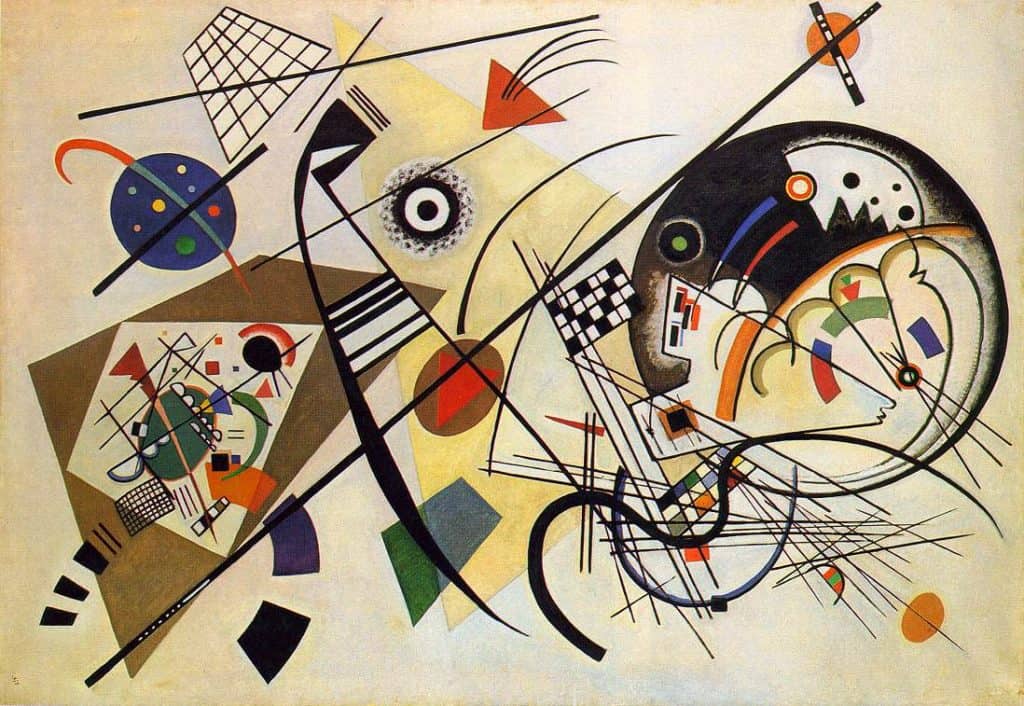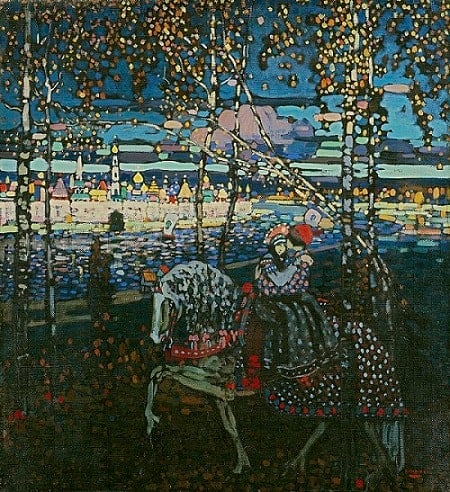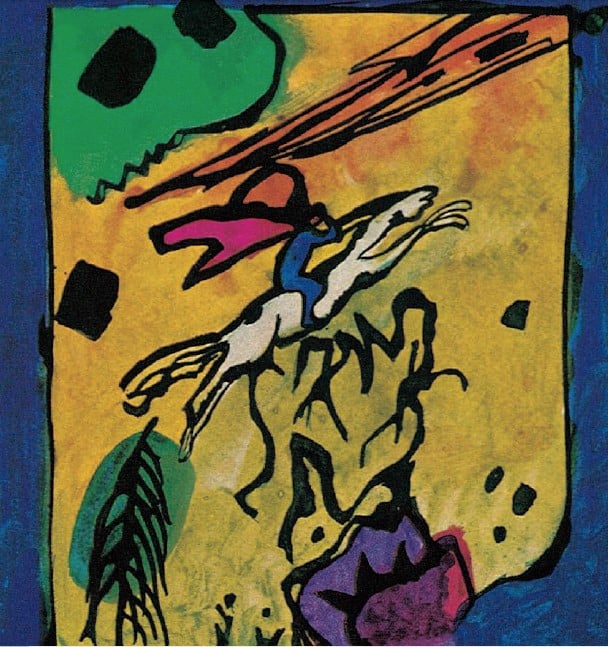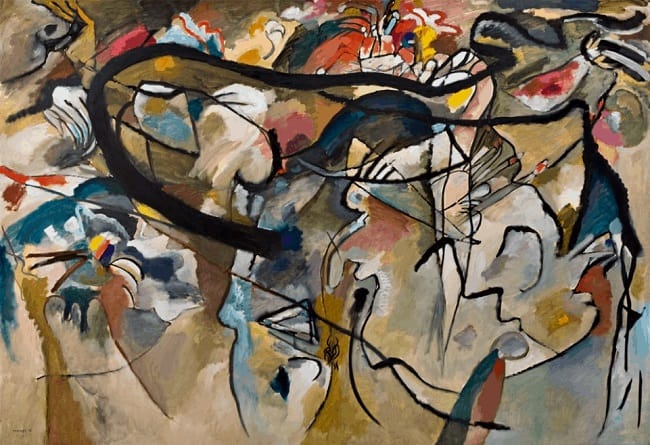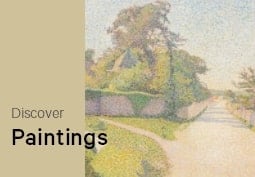Artists
Wassily Kandinsky – Life and Paintings of the Father of Western Abstraction
Anthony Dexter Giannelli
Wassily Kandinsky (or Vasily Kandinsky due to the variations produced when translating Cyrillic to Latin Alphabet) is generally hailed as the founder of abstraction in western art. Working during a tumultuous time in European history, he and his fellow artists involved in movements such as German Expressionism and Bauhaus helped to make the leap from the faithful representation of the world to the first solely abstract works in western art history. Inspired by the works of predecessors like Monet and Matisse, Kandinsky evolved the representational revolution past the hyper-stylized figurative form to burgeoning planes full of line and color innovation. As a result, a new, freer thinking surrounding what constituted accepted visual representation within the fine arts set the scene for numerous movements in western contemporary art today.
Biography of Wassily Kandinsky
Born in Moscow on December 4, 1866, Kandinsky spent much of his early life in Odessa. Although fascinated with art from a young age, he studied law and economics at the University of Moscow before declining a teaching position to fully pursue art at the Kunstacademie in Munich. The Bavarian city, bustling with cultural activity, would turn out to be the fertile ground for the development of avant-garde experiences. Kandinsky’s first works were inspired by post-impressionist examples; however, these highly stylized yet still figurative depictions of urban and natural landscapes, grew increasingly abstract with time and his search for spirituality. This quest would culminate with an outright rejection and breakdown of the object down to its building blocks: line, shape, and color, as he explained in his 1911 illustrated text Concerning the Spiritual in Art – one of the most influential theoretical writings in art history.
Along with fellow artists Gabriele Münter, Franz Marc, and a few others, Kandinsky founded the avant-garde group Der Blaue Reiter, one of the two faces of German Expressionism. A network of loose-knit artists rather than a coherent group, they were united by the aim to pursue the spiritual dimension of art, which they saw as the means to transcend reality and escape the alienation of the modern era. With the outbreak of World War I in 1914, the Der Blaue Reiter Project came to an end and the group members parted ways. Kandinsky returned to Russia where he spent the following 8 years highly involved in the national cultural institutions having directing positions in both the Institute of Artistic Culture and the Museums of Painterly Culture.
In 1922, he returned to Germany once again, following the political cooling and deceptive stability of post-World War I Europe. He had an imperative role within the Bauhaus, proponent of the synthesis of fine and applied arts to public and societal benefit. At the Bauhaus, Kandinsky taught the design class for beginners, and a course on his newly-developed color theory based on elements of form psychology. Growing older, he approached the final stage of his devotion to painting as the ultimate manifestation of spirituality; the rigidity of his geometric work was left behind in favor of the universal shape of the circle and increasingly organic pictorial images.
The progressive principles held by the Bauhaus and the artists associated with this movement were subject to the increased persecution residing over the cultural sphere taking shape in the formation of Nazi Germany. Kandinsky, in particular, found himself in the spotlight of Nazism’s purge of the so-called ‘degenerate art’. In 1933, the Bauhaus was forced to close and all its activities were halted. Kandinsky fled to France, where he would spend the remainder of his life until his death in 1944.
Was Kandinsky the First in Abstraction?
It was Kandinsky himself who described his 1911 work Composition V as the first-ever abstract painting in the world, but it has been also pointed out how Kandinsky had achieved the theorization and conceptualization of abstraction through his written works, long before he put paint to canvas on Composition V. However, the dispute over who created the work that was to bound to change art forever is a long-standing one, and probably one that cannot be resolved. Although Kandinsky has had an undeniable legacy in the development of modern art movements and beyond, it is important to contextualize his developments and pursuit of purely abstract expression.
On the one hand, when he produced Composition V, non-representational expression was by no means a new or modern concept, having been employed by numerous cultures around the world for a continuous period throughout human history. In this light, the “discovery” of abstraction by Kandinsky and his peers was rather a defiance of the prevailing bourgeois taste for figurative style in the West. On the other hand, the transition towards abstraction had already started years before with the Impressionist and Fauvist experiences, so the development of abstract art resulted from a collective direction rather than from the invention of an individual mind. Many argue that the political and societal instability faced by the West during the period of two World Wars poised both artists and audiences to begin to accept this new way of thinking and artistic expression that they would not have been likely to welcome in the past. And it was the freedom provided by the increased secularization in the 1900s that allowed the artists to break from the dogmatic tastes in their search for a renewed spirituality.
As stated by Masha Chlenova, one of the curators of MoMA’s 2012 exhibition Inventing Abstraction, 1910-1925: How a Radical Idea Changed Modern Art: “One can treat abstraction a little bit more abstractly, if you will, without ultimately being too concerned about who was first.”
Notable Works by Wassily Kandinsky
Picture with an Archer, 1909
Before making the final leap to pure abstraction, Kandinsky produced a successful portfolio of figurative works that yet held already true to the principles that governed his abstract practice, namely his pursuit of the spiritual. For instance, his Picture with an Archer placed most of the action and dynamic qualities of the composition within the sky or pointing towards the sky, with any human figures acting as secondary players, at times relinquishing their autonomy towards the engulfing aspirations of total spirituality residing above.
Composition V, 1911
Due to Kandinsky’s belief in the close correlation between sound and vision, many of his works borrow their titles from terms of the music lexicon such as ‘composition’ and ‘improvisation’. Through his 1911 work Composition V, Kandinsky sought to prove his prominence as the first abstract painter. “It’s the world’s first ever abstract picture – he stated – because back then not one single painter was painting in an abstract style. A ‘historic painting’, in other words.” Although a considerable step towards abstraction from earlier works, semblances of figures can still be seen, proving the point that there isn’t an exact boundary between figuration and abstraction, but rather a spectrum and middle ground between the two.
Klänge (Sounds),1913
Pursuing the synthesis within the arts, Kandinsky was particularly fascinated with combining inherent associations between image and sound. Heavily inspired by the work of composer Arnold Schoenberg, Through his 1913 book Klänge (Sounds), Kandinsky sought to create a set of abstract sounds through abstract woodcuts and poems. It has been speculated that Kandinsky had a neurological condition called ‘synesthesia’ in which one sense triggers another one, allowing, for example, the hearing of colors.
Several Circles, 1926
In later years, Kandinsky’s spiritual pursuits led him to more organic circular forms, taken from views into the microcosm. Kandinsky described the circle as “the synthesis of the greatest oppositions. It combines the concentric and the eccentric in a single form and in equilibrium. Of the three primary forms, it points most clearly to the fourth dimension.”
Relevant sources to learn more
Line Art. Follow Where It Leads
From Museum to Basement and Back: The Incredible History Of A Russian Avant-Garde Treasure
